This Pavlova Cake is the perfect dessert for Spring and Summer! Perfectly baked meringue that's crunchy on the outside and marshmallow on the inside, with freshly whipped cream and juicy berries on top.
I first posted this Pavlova cake recipe in 2021, and since then, I have added new photos, baking tips, and flavor variations based on your questions and feedback. It really is one of the best Pavlova recipes out there, and I hope you enjoy it!

Best Pavlova Cake Recipe
A classic Pavlova is one of the most basic yet most elegant and delicious desserts you can make. It has it all; it is visually stunning and with incredible taste and texture. And it's naturally gluten-free! But there are so many recipes out there, and it can be hard to know which one to follow.
This is the best pavlova recipe because it avoids the common problems others encounter, such as cracks and browning. Many recipes lead to cracked pavlovas or ones that break apart, it´s a big no! With this recipe, you get a perfectly white, crack-free pavlova every time, topped with luscious whipped cream and summer berries. Garnish with fresh mint, and you have the most delicious summer dessert ever.
Did you know that this dessert gets its name from the famous Russian Prima Ballerina Anna Pavlova? It was invented in her honor.
Katalin's Take On What Is The Secret Of a Good Pavlova
Making Pavlova cake is not difficult and doesn't take much time; however, like most meringue-based recipes, it requires attention, accuracy, and a bit of practice.
Meringue only uses a few ingredients you probably already have at home: mainly egg whites and sugar. Egg whites have a unique way of holding structure when air is whipped into them, but if there is any fat (e.g., egg yolk), it will fail.
So, first things first, you need to be careful when separating your egg whites from the egg yolks. I personally get better results from using fresh, whole eggs and separating them than from using store-bought egg whites in cartons. The egg whites must also be at room temperature and not cold from the fridge.
We need a little acid (no need for cream of tartar; a few drops of lemon juice or vinegar work fine), and we need to whip the egg whites and sugar together slowly. I'll tell you more below. We bake meringue low and slow, and let it dry out and cool while still in the oven with the door slightly open. Those are my key tips for the best meringue cake ever!
Not sure what to do with leftover egg yolks? You must try my ultimate Crème brûlée recipe.

This Is How To Make The Meringue Base For The Pavlova
Preheat your oven to 195°F (90°C), no fan. Yes, it is low! A low oven temperature is crucial for making the best meringue.
Prepare a baking tray by lining it with parchment paper or a silicone baking mat, and attach the whisk to your stand mixer.
If you are using cream of tartar as your acid, add it to the bowl of your stand mixer along with the room-temperature egg whites. If you are using lemon or vinegar as your acid, you will be adding it later.
Begin whisking the egg whites on low speed at first to build a good structure. If using vinegar or lemon juice, wait until the egg whites are foamy before adding one of them.
Once the egg whites are foamy, increase the speed to medium/high and start adding the superfine sugar. Add one tablespoon at a time and wait for it to be incorporated before adding the next one. This will take some time; be patient.
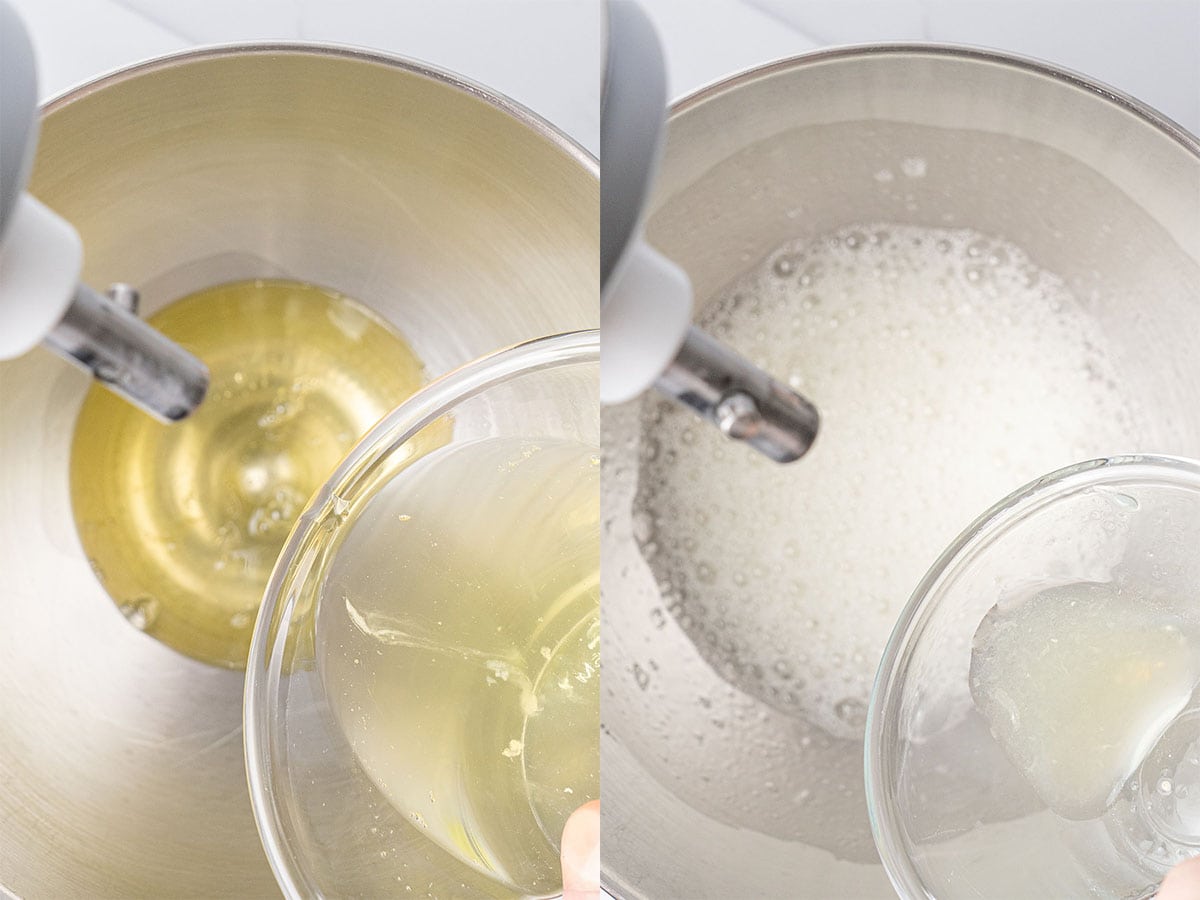
Once you have added all the sugar, turn the speed up to high and whip the meringue until it becomes thick, glossy, and holds stiff peaks. Turn the mixer off and rub a small amount between your fingers. It should be smooth, with no gritty feeling from undissolved sugar.
Finally, add the vanilla extract and salt and whip for a few more seconds.
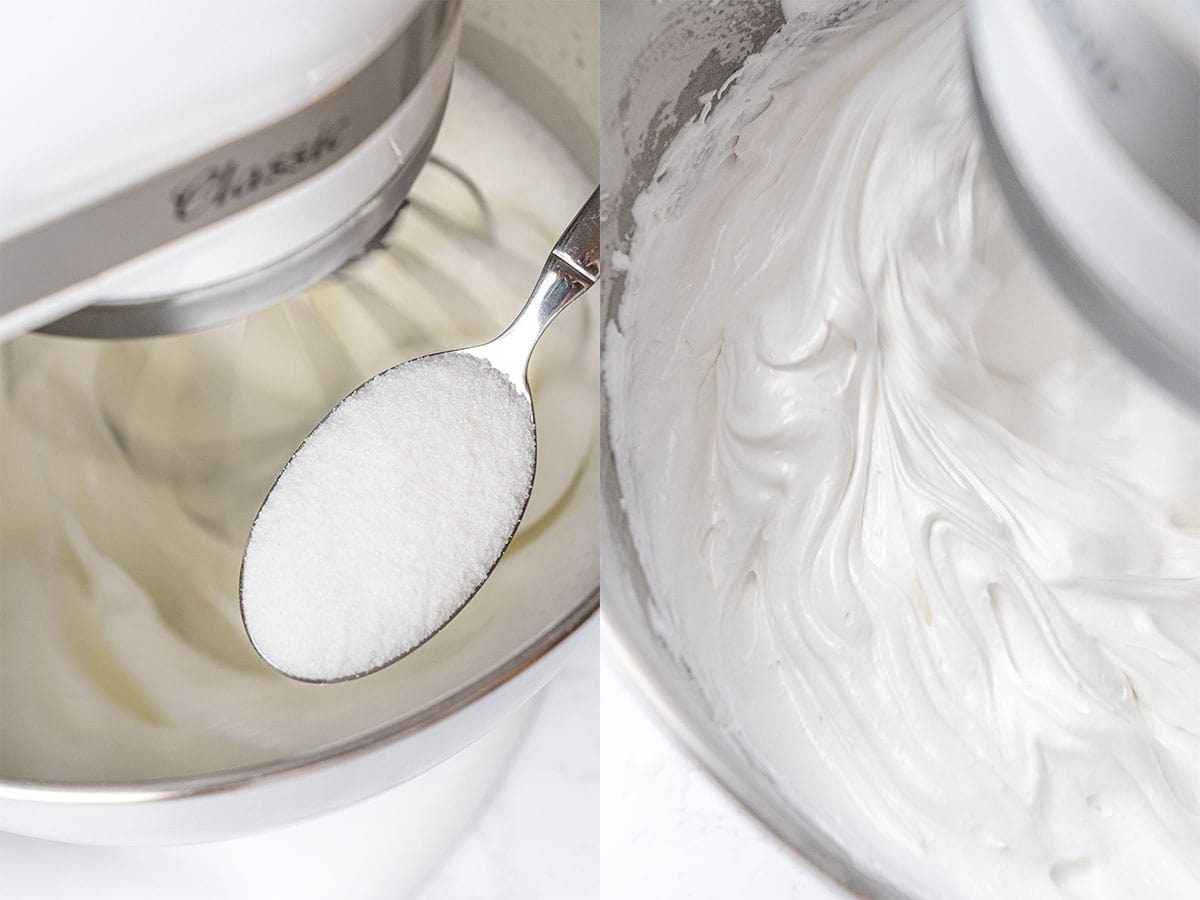
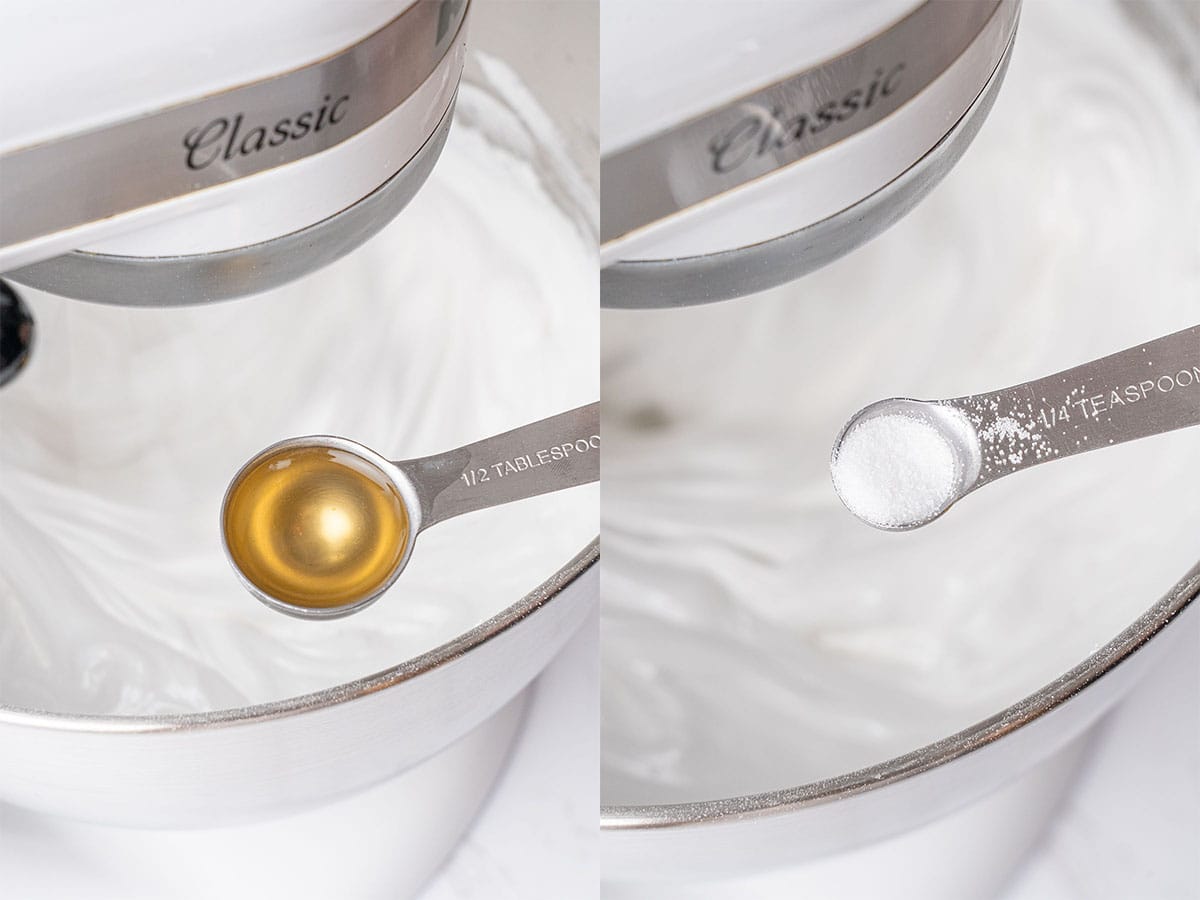
Gently fold in the cornstarch using a rubber spatula, being careful not to deflate the meringue.
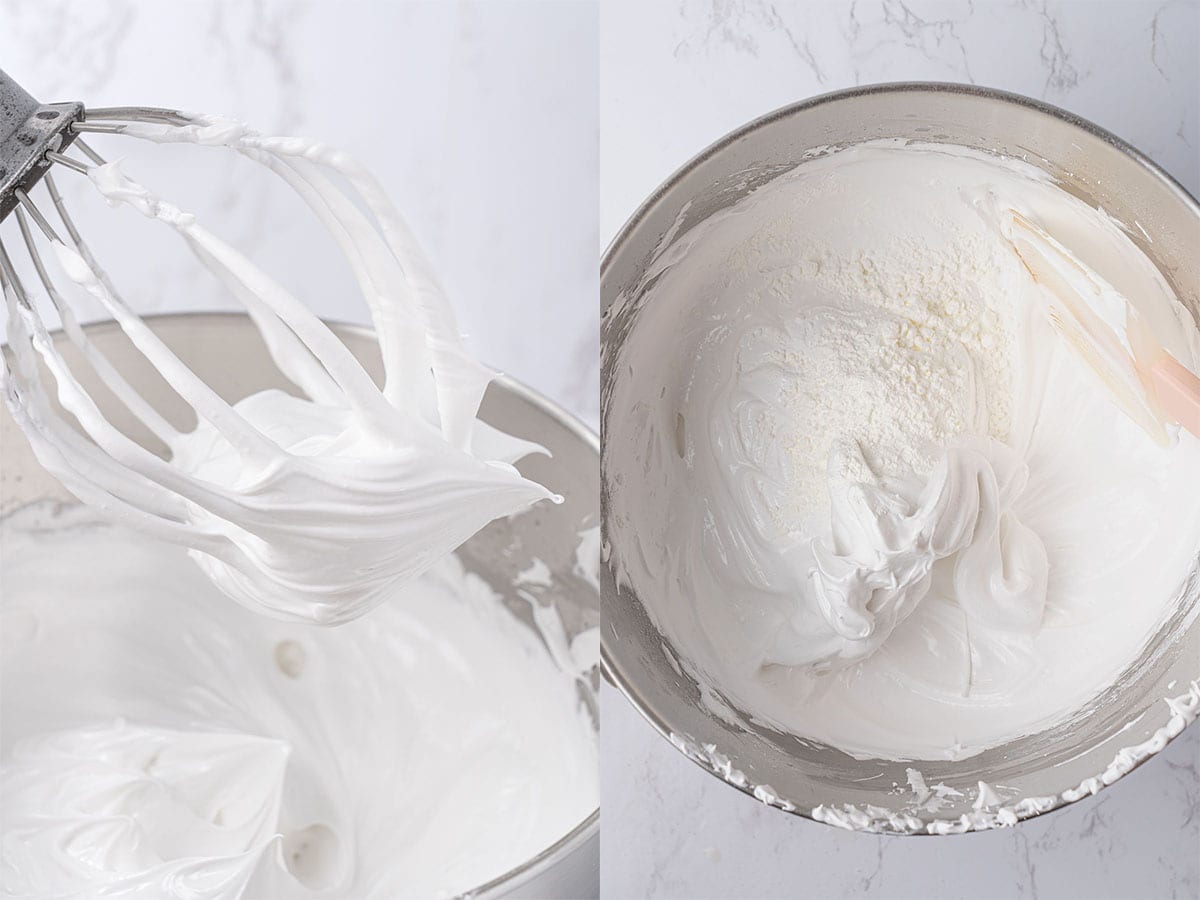
Bake Pavlova Like a Pro
Now you can decide what shape you want your Pavlova. The classic shape is a circle with a dip in the center for your fillings. But you can also make small nests to make individual mini Pavlovas.
You can transfer the meringue to a piping bag for this stage, or use a spoon or spatula. If you want to make a large Pavlova cake to share, spread or pipe the meringue onto the prepared tray in an 8-inch (20 cm) circle.
Use your spoon to make a shallow dip in the center. You can smooth the sides and edges with the back of a spoon or use a fork to create decorative swoops or peaks, if you like.
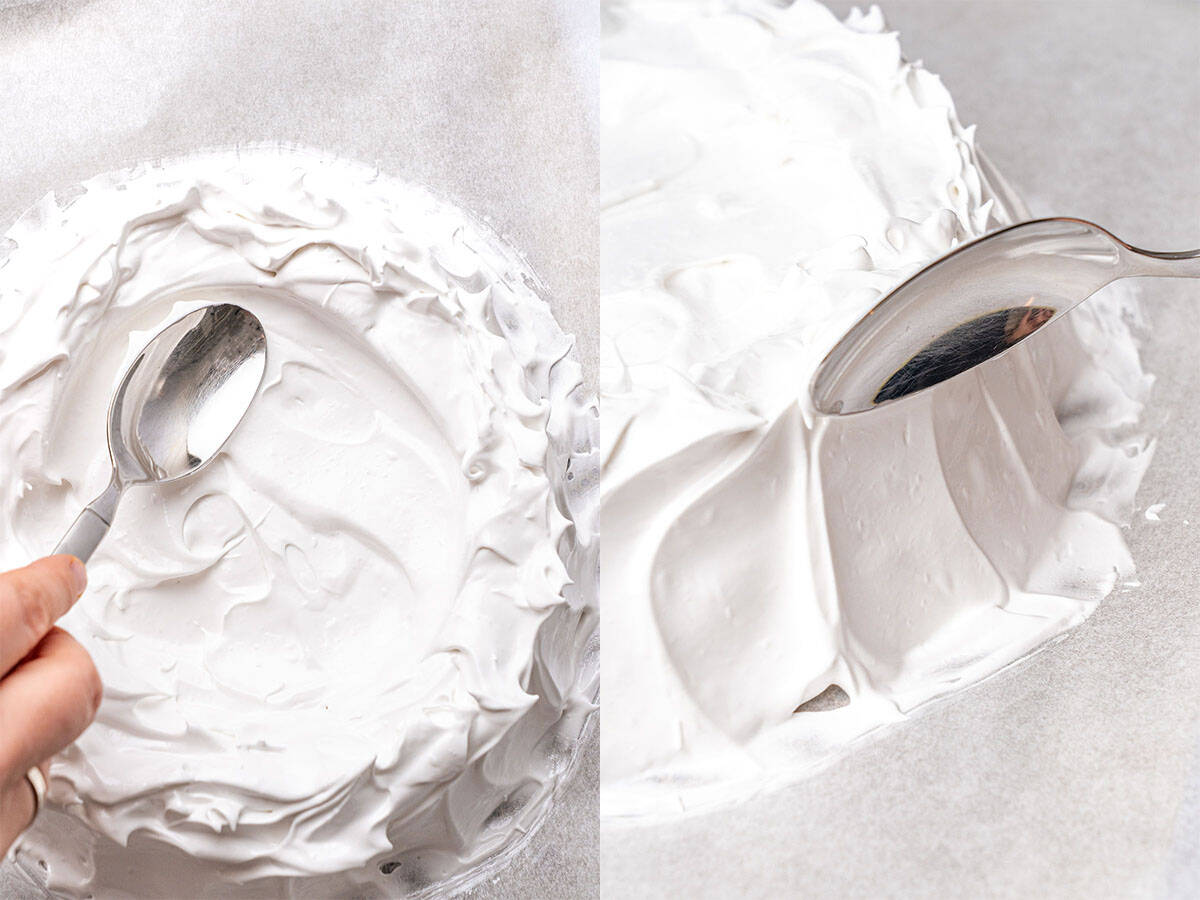
Bake the Pavlova for 2½ hours at 195°F (90°C). After 2 hours, check if it feels dry to the touch, but avoid opening the oven before this time.
Turn the oven off, but leave the Pavlova inside. Crack the door slightly open and let the oven cool down completely with the Pavlova inside it for several hours. This allows the Pavlova dry out and prevents cracking.
Fill It and Decorate
Wait until just before serving to fill your Pavlova cake so that the meringue is as crisp as possible.
Whip cold heavy cream and sifted powdered sugar together until soft peaks form. Then, add the vanilla extract and continue whipping until fluffy and pipeable. Don't let it go stiff!
Spoon the whipped cream onto the Pavlova cake and decorate it with fresh berries, such as strawberries and raspberries. Garnish with a few sprigs of mint and dust over some powdered sugar.
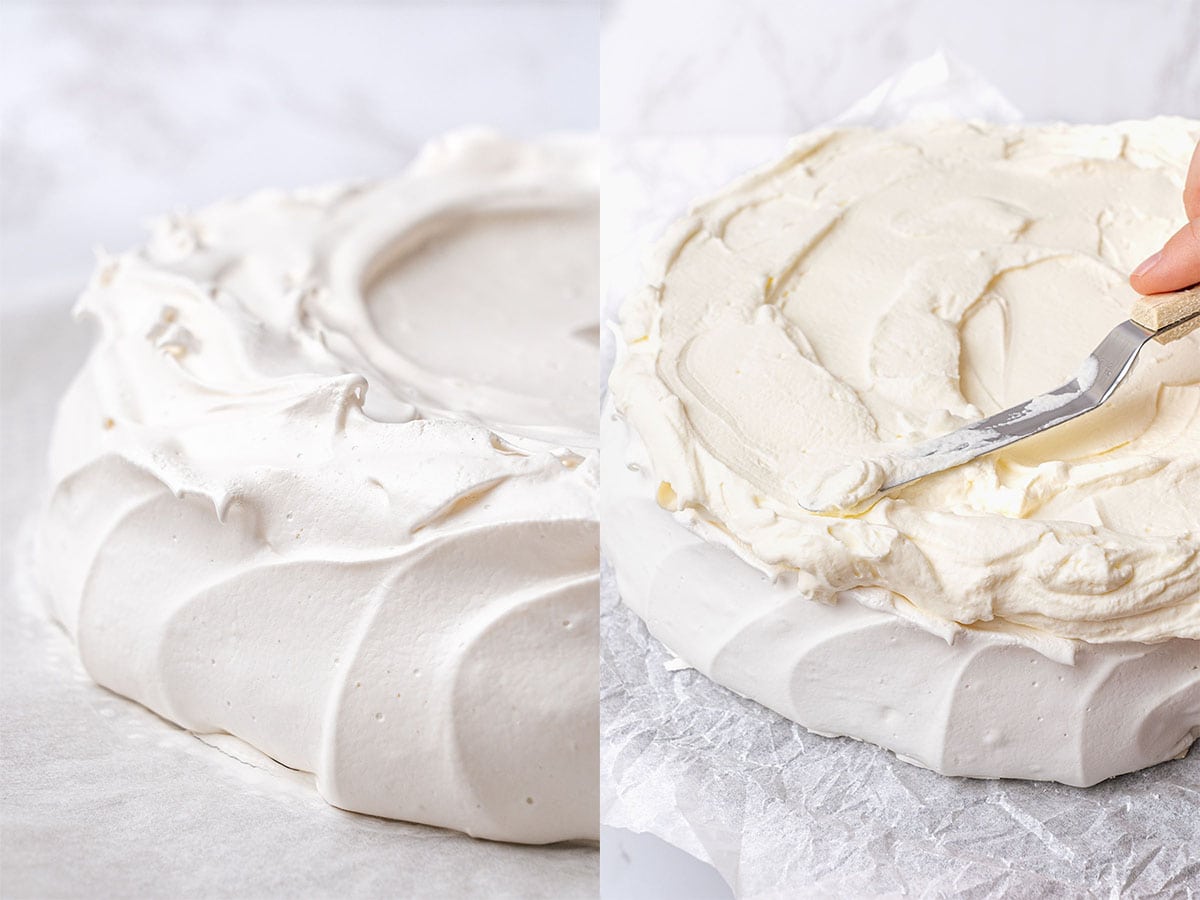
Leftovers? This Is How You Store It
Baked meringue can last up to 2 days in an airtight container on the counter or another cool, dry place. Once filled, the Pavlova cake is best enjoyed immediately, as the cream can make the meringue go soggy over time. If you do have any leftovers, store them covered in the fridge and enjoy them within a day.
You can freeze baked meringue to defrost and fill/enjoy later, although it won't be quite as crisp as it is when baked fresh. Freeze the meringue wrapped in foil and stored in an airtight container to protect its shape.
Try Some Other Fillings
You can try other fresh fruits like kiwi, mango, peach, or pineapple to make a tropical version of this Pavlova cake. Or, in winter, try some orange segments and pomegranate seeds for a festive taste, perhaps with some toasted hazelnuts, too. I also love to fill pavlova with my tangy lemon curd along with the whipped cream, to give it a citrus kick.
I generally avoid adding very sweet fillings (like chocolate or caramel) as there is already a lot of sugar in Pavlova. If you do want to add chocolate, I recommend a light drizzle of melted dark chocolate as a garnish only.
To take things up a notch, add a few drops of powder or gel food coloring at the end of the meringue mixing process to get a pretty color in your meringue.
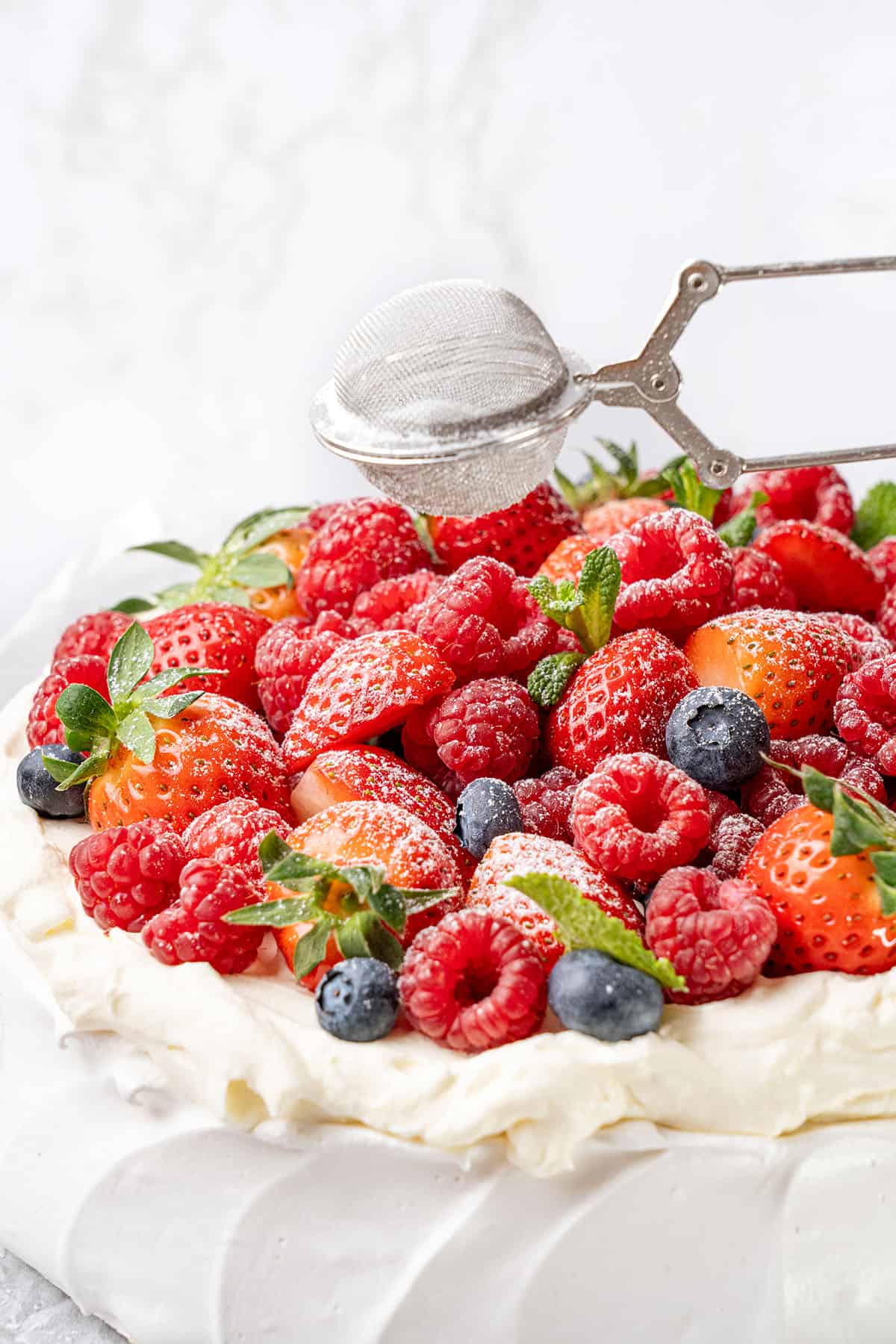
Do Not Substitute The Ingredients
The meringue recipe is very simple, and as such, nothing can be substituted. If you only have regular granulated sugar, you can pulse it in a blender to make it into fine sugar, but be careful not to overprocess, as it will turn into powdered sugar, which won't work.
Eggs cannot be substituted, obviously. Having said that, if one feels very ambitious, aquafaba is usually a good egg white substitute, but most probably, you will need to reformulate the recipe entirely.
Troubleshooting
Here are some common problems with meringue and how to avoid them!
The meringue doesn't whip up properly - there is either fat in your egg whites or on your equipment. This may have come from egg yolks, but may also be from past baking (e.g., whipping butter and sugar together in the same bowl previously).
The meringue cracked or split - check the weight of your ingredients, as the ratio may be wrong. Cream of tartar, vinegar, or lemon juice adds stability to the structure, helping to avoid cracks. It may also be due to your oven being too hot or taking it out too soon, so it couldn't dry out properly.
The meringue goes brown - your oven is too hot. Check the temperature with an oven thermometer.
Expert Tips For Making Pavlova Cake
- Egg size will differ in weight/size by country (e.g., a large egg in the US is smaller than a large egg in the UK), and even then, they can vary within a carton. The only way to guarantee accuracy in the ratio of egg whites to sugar is to weigh your egg whites.
- Wipe all your equipment with a paper towel soaked in vinegar before you start to remove any residual fat traces. So wipe out the bowl, wipe the whisk attachment, and so on.
- Even if there is one tiny speck of egg yolk in your egg whites, the meringue will fail. Be very careful not to pierce the egg yolk when separating the eggs.
- Cornstarch is not completely essential, but it is the secret to the best pavlova marshmallow center, so you should definitely include it.
- Don't bake anything else in the oven while you are baking the meringue, as it will add steam to the environment and affect the outcome of your pavlova cake.
- Allow the pavlova cake to cool and dry completely in the oven before using it.
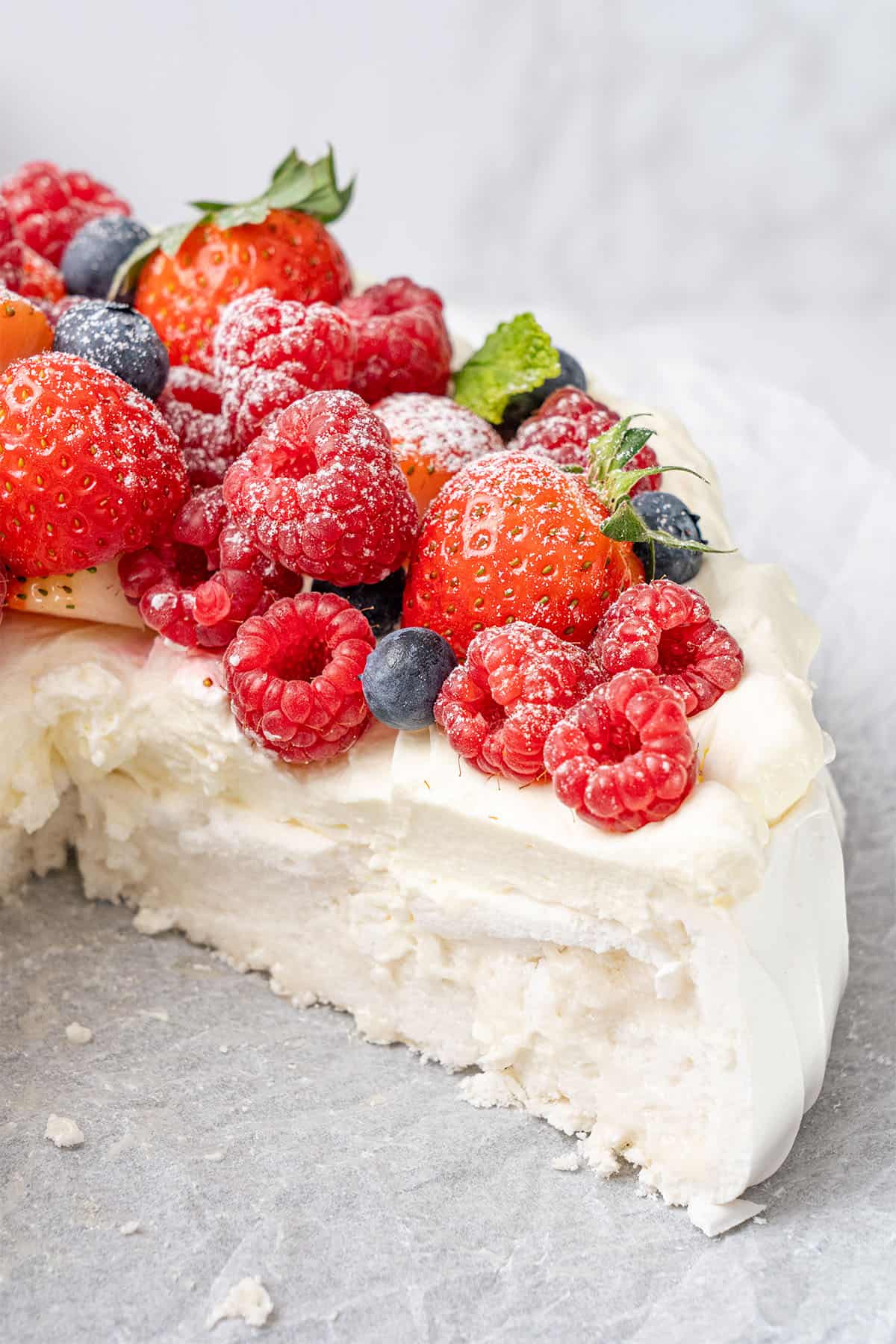
Useful Equipment
Weigh your egg whites and sugar using a digital scale for accuracy.
A stand mixer will make your life easier when whipping meringue, but you can use an electric hand whisk, too.
I use a piping bag without a nozzle to pipe pavlova cake, but you can also use a spoon or rubber spatula.
Always check that you are baking at the right temperature with a digital oven thermometer! If your oven is too hot, you will not get a perfectly white meringue with no cracks.
Try Some Of My Other Dessert Recipes
Looking for more summer showstopper desserts to make? Try some of these next:
And be sure to check out my strawberry desserts roundup, too.
Have you tried this recipe?
Please leave a 5-star ⭐️⭐️⭐️⭐️⭐️ rating on the recipe card and consider leaving a comment as well!
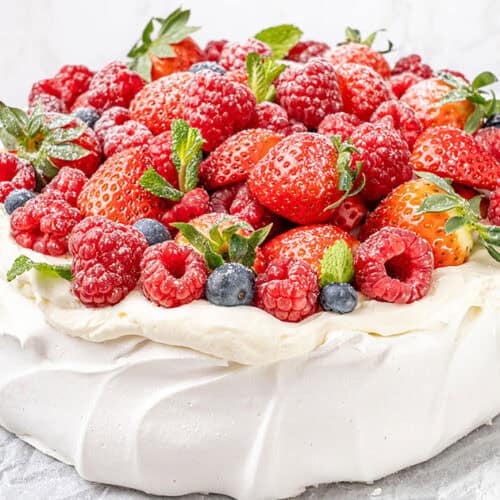
Pavlova Cake
Equipment
- Digital scale
Ingredients
Pavlova
- 180 g (¼ cups) Egg whites whites of approx. 6 eggs (approx.)
- 300 g (⅔ cups) Super fine sugar If you don’t have superfine sugar, you can pulse regular granulated sugar in a food processor for a few seconds until it’s finer but not powdered.
- 1½ teaspoon Cream of tartar can be substituted with ½ tablespoon freshly squeezed lemon juice or vinegar
- 1 tablespoon Corn starch
- ½ tablespoon Vanilla extract
- ¼ teaspoon Salt
Filling
- 230 g Heavy cream 36% fat content, use it very cold
- 30 g Powdered sugar
- 1 teaspoon Vanilla extract
- Fresh berries
- Powdered sugar
- Mint
US customary cup measurement is an indicative figure only. Measure the ingredients with a digital scale by weight (gram). Baking is art but also science which requires precision and accuracy.
Instructions
- Preheat the oven to 195°F (90°C), no fan. Line a baking tray with parchment paper or use a silicone baking mat. Double-check your oven’s true temperature with a digital oven thermometer if you have one—it really makes a difference for pavlova.
- You’ll need something acidic to help stabilize the egg whites. You can use cream of tartar, lemon juice, or vinegar. If using cream of tartar, begin whisking room temperature, fresh egg whites on low speed in a stand mixer with the cream of tartar added right at the start. If using vinegar or lemon juice, wait until the egg whites are foamy before adding one of them.
- Once the egg whites are foamy, start adding the superfine sugar slowly—one tablespoon at a time—while increasing the mixer speed to medium-high. Be patient; this step is crucial.
- After all the sugar has been added, whip the meringue on high speed until it becomes thick, glossy, and holds stiff peaks. Test a small amount between your fingers—if it feels gritty, keep whisking. You want the sugar to fully dissolve without overwhipping the meringue, which can cause it to become lumpy and unstable.
- At this point, add the vanilla extract and salt, then whip it for a few more seconds.
- Then, using a rubber spatula, gently fold in the cornstarch, being careful not to deflate the meringue.
- Spread or pipe the meringue onto the prepared tray in an 8-inch (20 cm) circle. Shape it with a spoon or spatula so that the edges are slightly taller and there’s a shallow dip in the center to hold your filling later. You can make decorative swoops or peaks on the sides if you like.
- Bake for 2½ hours at 195°F (90°C). Begin checking it around the 2-hour mark. The pavlova should feel dry to the touch.
- Once baked, turn off the oven and leave the door slightly open. Let the pavlova cool completely inside the oven for several hours to prevent cracking.
- Before serving, whip cold heavy cream and powdered sugar until soft peaks form, then add the vanilla and continue whipping just until fluffy and pipeable.
- Decorate with fresh fruits, mint, and powdered sugar, if desired.
- Undecorated pavlova storage: Store in an airtight container at room temperature for up to 2 days. Keep it in a cool, dry place away from humidity—never in the fridge, as moisture will make it sticky and soggy.Decorated pavlova storage (with cream and fruit): Once topped, pavlova should be served immediately or stored in the refrigerator for up to 1 day. After that, the meringue will start to soften and lose its crisp texture.
Notes
Ingredient Notes
- Use fresh, room-temperature egg whites for the best volume and stability. Avoid carton egg whites—they don’t whip up as well. Make sure there's no trace of yolk.
- Superfine sugar dissolves more easily into the meringue, resulting in a smoother texture. If you only have granulated sugar, pulse it briefly in a food processor.
- Acid (Cream of Tartar, Lemon Juice, or Vinegar): A small amount helps stabilize the egg whites and strengthens the meringue structure. Choose one and add it at the right time depending on the type (see technique notes).
- Cornstarch is the secret to the pavlova’s marshmallow-like center. It softens the inside while keeping the shell crisp.
- Use high-quality vanilla extract for the filling; try my homemade vanilla extract.
Technique Notes
- To start, make sure all your equipment—mixing bowl, whisk, and spatula—is completely clean and dry. Even the tiniest bit of fat or egg yolk can prevent the egg whites from whipping properly, so take extra care when separating the eggs. Arrange everything you need ahead of time for a smooth process.
- Start at a low speed to build small, stable bubbles, then gradually increase speed. This creates a more stable meringue.
- Stop whipping the meringue once it´s glossy and forms stiff peaks. Overwhipping can cause the meringue to collapse or become lumpy.
- Do not take out the pavlova from the oven straight after baking. Letting it cool in the oven while the door is slightly open prevent cracking.

Rhonda McQuirter
You have some nice-looking recipes but as an FYI I highly recommend you put a title description on at least ONE of your pictures. I have a lot of recipes saved on Pinterest and without a title you can't tell what anything is, and it's just too time consuming to click on each picture to find out what it is. They become a blur of little, tiny pictures. Consequently, I will no longer save a recipe without a description. I have to believe I am not alone. Unfortunately, Pinterest itself is so unfriendly it won't let us add a title or it wouldn't be an issue. I hope you take this with the kind intent it was meant as a suggestion for a way to improve your page.
Katalin Nagy
Thanks that is a very valuable comment from a user experience point of view, I will look into this.
Stefania Stephens
I’m truly obsessed with your website. I’ve done SO many of your recipes and they’re all fantastic. I love all the details and how much time you take to explain every single step. Your passion is well transmitted in every recipe. You have made me, fall in love into the art of baking. Thank you
Emina
Amazing! If you follow the recipe and all the tips, you are guaranteed to have a perfect Pavlova 😍
I’m so happy to found your page, all the recipes are so well written and explained. We loved strawberry nobake cheesecake, Tiramisu cupcakes are next on the list 🙂
admin
Thanks for your lovely rating, feel free to send me a pic on IG when next baking my recipe! Tiramisu cupcake indeed a great choice:)!
Karen
I’m a big fan of you i love your unique ideas . You’re so professional and your desserts look yummy .